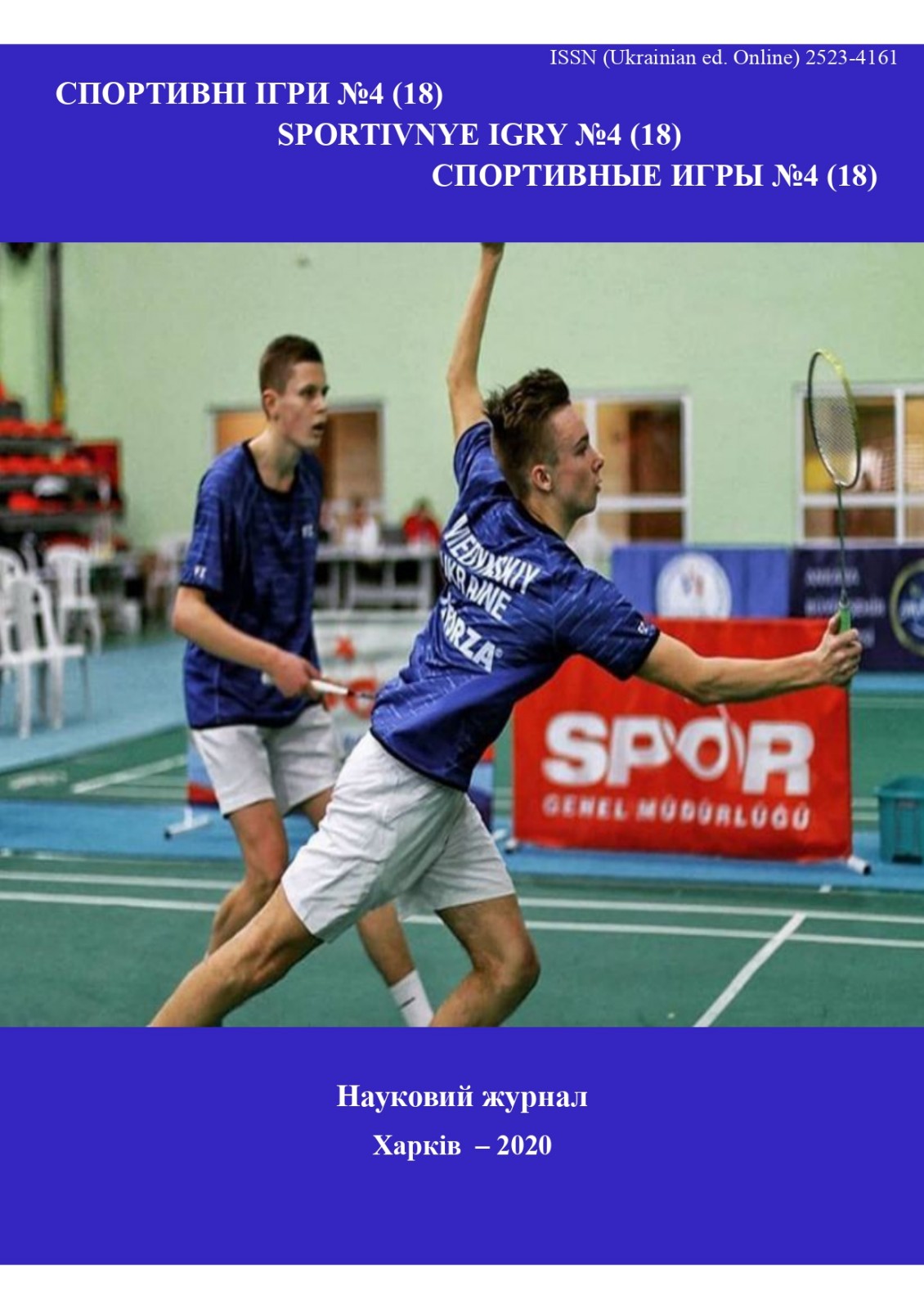The accuracy of the scales for results evaluation in test exercises using linear regression equations and levels of students’ physical training in higher education establishments
Keywords:
physical education, grading scales, physical exercises, students, physical training levels, linear and multiple regression equations, determination coefficient and approximation coefficientAbstract
The study compares two scales
that assess achievements based on mathematical modelling of different methods of giving marks to
students for physical education. Aim: Improvement of the methodology for results evaluation in test
exercises using levels of students’ physical training. Methods: Theoretical analysis and
generalization; testing; linear interpolation method; least square method; method of graphs;
correlation and regression analysis. Materials: We have studied the quality of the scales which give
marks according to either linear regression equations or assessment of levels of physical training.
The quality of the scales has been analyzed with the coefficients of determination and the average
error of determination in per cent. In order to provide an integral approach to the accuracy of the
scales, we have used the indicators of the suitability of multiple regression equations, which have
been obtained by two methods of getting marks, to assess physical preparedness in different
students’ groups. Multiple regression equations have been calculated with the students’ results of
1st–3rd years of studies (N = 142) in four test exercises. Results: It has been found that the scales
whose marks were calculated according to the linear regression equations have a higher accuracy
in assessing both the reference point of test exercises and the students’ physical fitness compared to
the scales that determine the marks for the levels of physical training. Conclusions: The scales for
results evaluation using linear regression equations are characterized by good fitting
(D = 99.93÷100 %) and high accuracy in giving marks (Ā = 0.09÷0.53%). The scales that
determine the marks using the levels of physical training, have good fitting (D = 93.81÷94.05%),
yet insufficient estimation accuracy (Ā = 12.07÷13.03 %), which does not allow obtaining a single multiple regression equation suitable for assessment of the physical training in different semesters and years of studies. It has been found that, on average, the scales for results evaluation using linear regression equations give 0.44±0.30 or 17.1 % higher marks compared to the assessments of
the scales that are obtained using the levels of physical training.
References
Базака, Л.Н., & Разинков, А.И. (2015). Статистическая обработка данных в среде пакетов Statistica, EViews и MS Excel: методические указания по выполнению лабораторных работ. Пинск : ПолесГУ.
Болтєнкова, О.М. (2010). Визначення рівня фізичної підготовленості студентів як умова створення науково-обґрунтованої системи їх оцінювання на заняттях з фізичної культури. Слобожанський науково-спортивний вісник спортивний вісник, 4, 44-47.
Грибан, Г.П. (2014). Особливості фізичної підготовленості студентів вищих навчальних закладів України. Вісник Чернігівського національного педагогічного університету.Сер. : Педагогічні науки. Фізичне виховання та спорт, Вип. 118 (1), 88-92. http://nbuv.gov.ua/UJRN/ VchdpuPN_2014_118(1).
Заневський, І.П. (2011). Точність шкал оцінювання рівня фізичного здоров’я. Частина 1. Інтер- та екстраполяція шкали оцінювання. Фізична активність, здоров’я і спорт, 2 (4), 8-19.
Зациорский, В.М. (Eds.). (1979). Основы спортивной метрологии. М. : ФиС. Квєтний, Р.Н., Богач, І.В., Бойко, О.Р., Софина, О.Ю., & Шушура, О.М., Квєтний, Р.Н. (Ed). (2012). Комп’ютерне моделювання систем та процесів. Методи обчислень. Частина 1 : навч. посіб. Вінниця : ВНТУ.
Кремер, Н.Ш., Путко, Б.А., & Кремер, Н.Ш. (Ed). (2007). Эконометрика : учебник для вузов. М. : ЮНИТИ-ДАНА.
Лакин, Г.Ф. (1973). Биометрия : учебн. пособ. для универ. и пед. ин-тов. М. : Высшая школа.Михайлов, Віт.В., Михайлов, Вол.В., & Коростильова, Ю.С. (2015). Оцінювання оздоровчої ефективності фізичного виховання за рівнем морфофункціональної та фізичної підготовленості студенток ВНЗ. Актуальні проблеми розвитку традиційних і східних єдиноборств : Збірн. наук. праць IX Міжн. наук.-метод. конф. Вип. 9 : Національна академія Національної Гвардії України, 173-181. http://avv.gov/ua.
Михайлов, Віт.В., Михайлов, Вол.В., & Коростильова, Ю.С. (2016). Морфофункціональна підготовленість за оцінкою маси тіла та ЧСС студентів ВНЗ. Сучасні технології в сфері фізичного виховання і спорту та валеології : Збірник наук праць Х Міжн. Інтернет наук-метод. конф. Вип. 10 : Національна академія Національної Гвардії України. 202-216. http://avv.gov/ua.
Михайлов, Віт.В., Михайлов, Вол.В., & Коростильова, Ю.С. (2019). Застосування рівнянь регресії для оцінювання ефективності виконання тестових вправ у фізичному вихованні студентів закладів вищої освіти. Спортивні ігри, 4 (14), 35-47. doi: 10.15391/si.2019-3.05.
Начинская, С.В. (2008). Спортивная метрология. М. : Издательский центр «Академия».
Начинская, С.В. (2012). Спортивная метрология : учебн. для студ. учреждений высш. проф. образования. Изд. 4-е, стер. М. : Изд. центр «Академия». ISSBN 978-5-76-9264-5.
Иванов, В.С. (Eds.). 1990. Основы математической статистики : учебное пособие для интов физ. культ. М. : ФиС.Лещинський, О.Л., Рязанцева, В.В., Юнькова, О.О., & Юртин, І.І., Юнькова, О.О. (Ed). (2009). Практикум з економетрії: навч. посіб. К. : ДП «Вид. дім «Персонал». ISBN 978-966-608-841-6.
Рогачев, А.Ф., & Мелихова, Е.В. (2014). Эконометрика : учеб. пособие. Волгоград : ФГБОУ ВПО Волгоградский ГТУ.
Руська, Р.В. (2012). Економетрика : навч. посібник. Тернопіль : Тайп.













